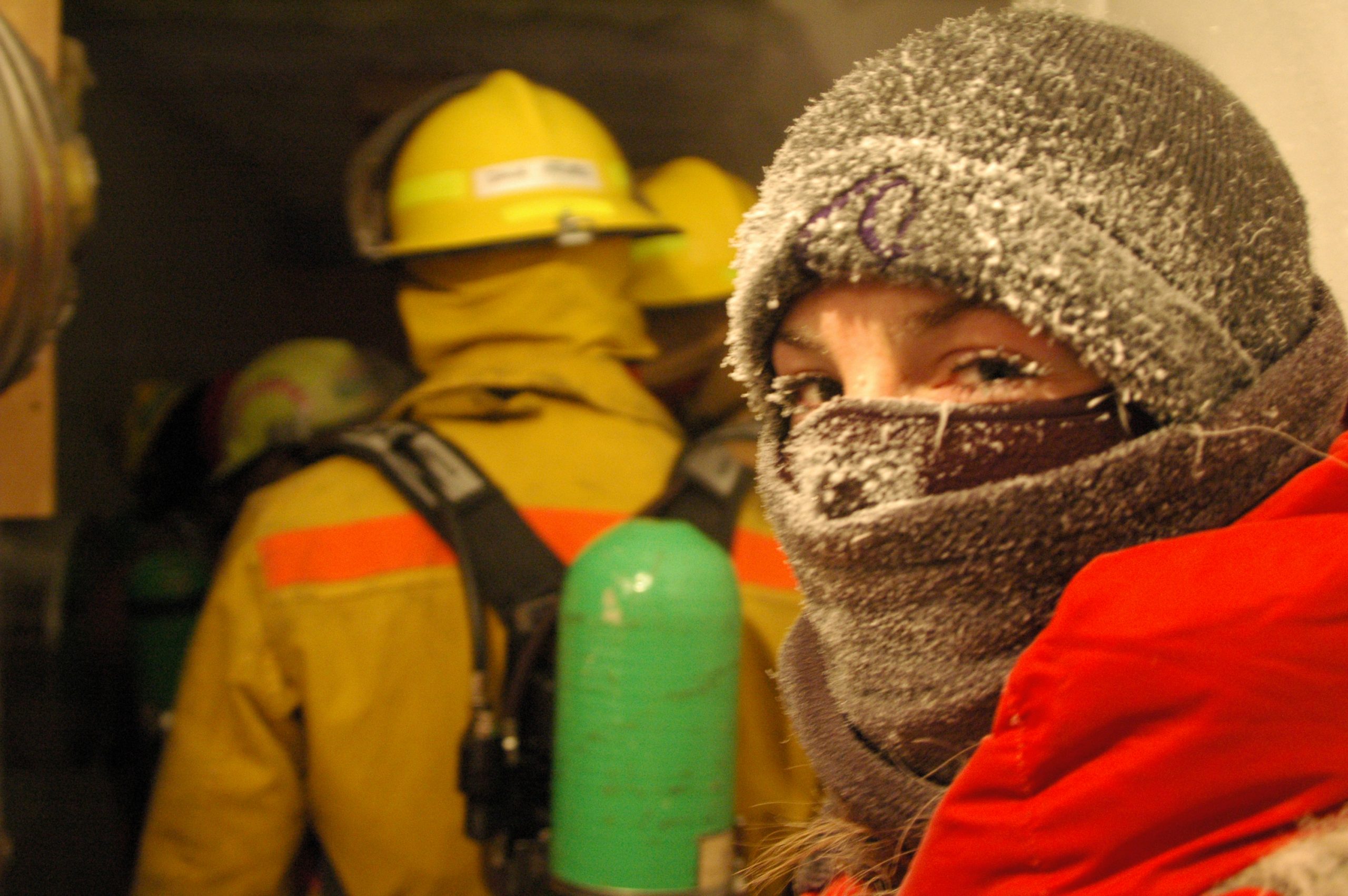Things are really swinging here at the Pole now. I’ve joined the South Pole Station Fire Brigade and we’ve had a few fire alarms, but no fires thank goodness. I’m working in the station greenhouse. And oh yes, there’s still plenty of snow shoveling. But the shoveling has declined as other projects start to demand more labor.
Windy Work
Last week we had a change in the weather. The winds shifted about 30 degrees and picked up speed. From what I gathered from the meteorologists, a low pressure system formed or moved into the Weddell Sea and due to the lay of the Trans-Antarctic Mountains, it influences our weather. Opposite the Weddell Sea from us, a high pressure system started flowing towards the low pressure system and we were caught right in the middle of the exchange. That exchange included a fairly constant 25 knots of wind with peaks up to 32 knots. I was assigned to work outside in the Dark Sector that day, and it was glorious.
Another GA and I were tasked with putting up some orange safety fencing around the ICE CUBE neutrino science project drill camp. They’re preparing to drill up to 70 holes roughly 2.5km deep over the next few seasons. In the shaft’s dark depths they hope to capture the rare occurrence of a neutrino colliding with an ice particle — the process emits a faint blue light. From this, scientists can determine a number of things that will help unravel some of the mysteries of the universe.
But as we worked on the fencing that day, the wind blew against me, buffeting my jacket. I had my goggles on and my face covered. The loose particles of snow scurried along the ground, flowing like a river over my boots and between my legs. I glanced up for a moment into the wind. There was nothing. Nothing but the great white expanse of the Antarctic Plateau, the horizon partially blurred by the stirred snow and clear blue sky above the fray. For a brief moment I felt as if I was the only living soul on the continent. I had all of Antarctica to myself. I shared it only with the wind.
Fire Brigade
Last Sunday I trained on the SCBA (Self Contained Breathing Apparatus) gear used by the South Pole Station Fire Brigade — part of the equipment required to be a member of Team II. The station has four response teams who work together in the event of an emergency. Team I is the hasty response team. They respond directly to the alarm. Most of them have access to snowmobiles and can zip around the compound to the scene. Team II is the bunker gear and SCBA team. We respond to our locker with our bunker gear and then continue to the scene. Team III is a support team and they go to the supply area and bring ventilation fans, more SCBA bottles and other tools needed by Team II. Finally, there is Team IV, the Trauma Team. If anybody is hurt, Team II gets the injured party to Team IV and they take care of them.
Fire Alarms
In the past few days we’ve had a handful of alarms in the Summercamp bathroom buildings. One of the hot water boilers has been acting up and spewing smoke and odors that cause the alarm to activate. Every time this has happened it’s either been late at night or early in the morning. So far, I’ve always been in bed and heard the general alarm blaring over the loudspeakers. At the sound I’ve jumped out of bed, dressed, and headed out. Since I’m already practically on the scene I don’t run all the way back to the New Station (where our gear lockers are located) to get my gear on, but check the fire panel for the alarm’s source, grab an extinguisher and go directly to it. The first time was about 2130h and two UTs (Utility Technicians) were working on the boiler when it set the alarm off. The second time was a day and a half later at 03.30h and nobody was working in the boiler room. I was the first emergency responder on the scene. When I saw there were no flames or danger, I hit the emergency shutoff switch for the boiler and called the situation in to COMMS, our communication center. Within moments my fellow Team II members started showing up in their bunker gear and SCBA.
A UT arrived on the scene, the situation was determined safe, and I went back to bed. I guess the alarm sounded again, but only briefly while the UT was working on the boiler. I never heard it, I was sound asleep.
Greenhouse
The greenhouse work is a nice way to see and work with plants. What a change down here where nothing grows in the natural environment. Nothing but white everywhere. The greenhouse, or “Growth Chamber” according to the sign on the door, is located in the new elevated station. It’s about 30sqm with two racks of plants. The winterover crew had planted some vegetables so our first session was harvesting lettuce, tomatoes and cucumbers. The chamber can’t grow enough food to feed the winterover crew much less the 200+ of us here for the summer season, but it does supply some fresh produce (aka “freshies”) to the winterover crew who otherwise don’t get any because there are no flights in during the winter.
For those of us here in the summer, we do get fresh fruit and veggies flown in now and then, but it’s nice to keep the greenhouse going. Plus, it’s just fun to garden at the South Pole! Some of the folks wintering over next season are already here and they’re learning how to use the greenhouse — it’s a special kind of greenhouse using a method known as hydroponics. But now that we’ve harvested, it’s time to plant again. We use something called “rock wool” in which we incubate the seeds. Then, once they sprout, we transfer them to a regular growth tray where we feed them water and nutrients. Of course there is also the regular pruning and plant care that must go on daily. A pretty large crew helps with the greenhouse, so each individual only has to put in about an hour a week to keep things going.
Job Update
And then there’s that little activity here that I do for about nine hours a day: work. Work is actually going pretty well. We may not be out on the berms shoveling for a solid nine hours a day but there are still plenty of opportunities to shovel snow. When we’re not shoveling we’re assigned other projects around the station. Again, some of them involve digging specific equipment out so it can get set up and used. Most recently I’ve been working on getting the ICE CUBE science project set up. This has involved building the caution fence, setting up caution tape around trenches, putting flags in to show where a cable is buried and even plowing up the road to build a culvert for the aforementioned cables and hoses to run through.
Separate from the science sector where we’re helping set up specific projects there is the continued construction of the new station and some of the outlying buildings that will serve as office space for the scientists. This past week I helped the electricians set up lights and ground suspended cable trays from the ceiling that will carry networking cables to each of the work stations. I’m getting a lot of experience in various construction fields. The process is teaching me new tool names, new skills and a better appreciation of what it takes to build something. I even rode a snowmobile for the first time ever when I got here. Now I’m often ferrying people and/or supplies around the station compound via snowmobile. By the end of the season it may well become old hat, but for now the thought that I’m snowmobiling in Antarctica puts a big smile on my face. Not that anyone would know because I have to cover up all exposed skin while riding to guard against frostbite.
Today it’s Sunday again and my day off. In fact, most of the station has the day off, save some of the cooks, God bless them. It’s been a relaxing day. I worked on getting this update ready to go, strolled into brunch, had a fire team meeting to debrief the alarms of the week, watched “Strange Brew,” and tonight is a science lecture on the weather we experience here at the Pole. I hope to get to bed early as it’ll be an early start to kick off the work week first thing tomorrow morning.


